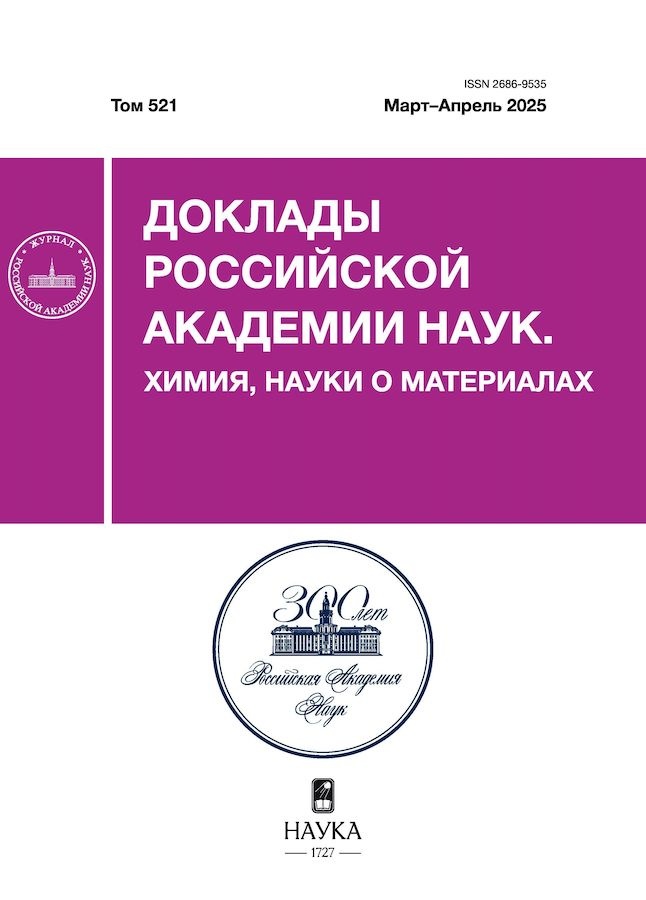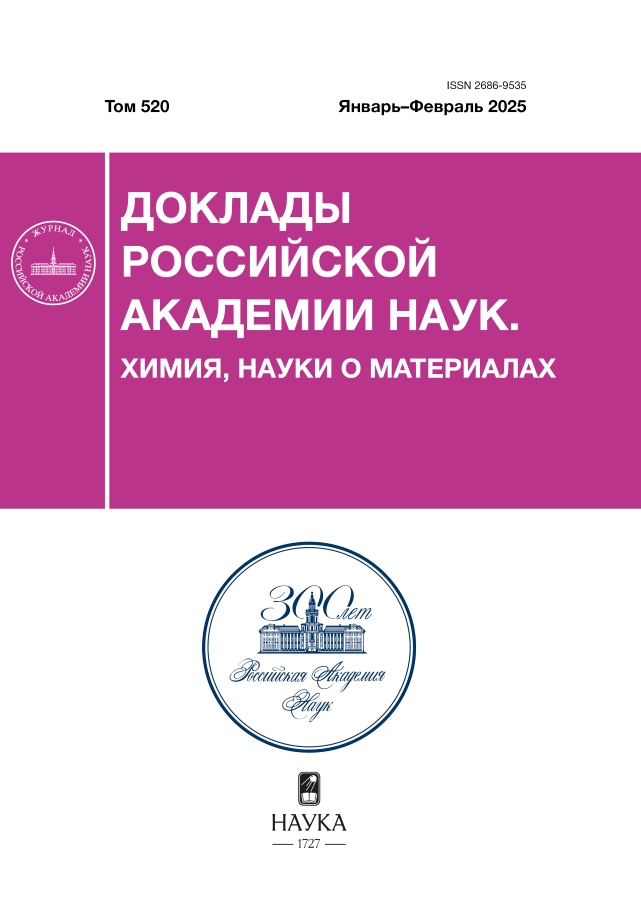Исследование механизма реакции NHC–R- и NHC=O-сочетаний, активируемых медью, в условиях системы Чана–Эванса–Лама
- Авторы: Галушко А.С.1, Скуратович В.А.1, Грудова М.В.1, Ильюшенкова В.В.1, Шайдуллин Р.Р.1, Прима Д.О.1
-
Учреждения:
- Институт органической химии им. Н.Д. Зелинского Российской академии наук
- Выпуск: Том 520, № 1 (2025)
- Страницы: 3-11
- Раздел: ХИМИЯ
- URL: https://snv63.ru/2686-9535/article/view/683262
- DOI: https://doi.org/10.31857/S2686953525010019
- EDN: https://elibrary.ru/AWXFQC
- ID: 683262
Цитировать
Полный текст
Аннотация
В данной работе впервые рассмотрены явления образования частиц NHC–R и NHC=O, индуцированное медью, в реакционной системе арилирования анилина по Чану–Эвансу–Ламу. Рассмотренные сочетания между карбеном NHC и остатками арилбороновой кислоты были продемонстрированы с использованием 5-ти различных арилбороновых кислот и трех комплексов Cu/NHC. Также показано, что образование азолона NHC=O происходит за счет переноса кислорода из атмосферы с помощью меди на карбеновый центр NHC. Комплексом экспериментальных физико-химических методов анализа, а также с помощью методов квантовой химии впервые показано, что путь деградации комплексов Cu/NHC через образование частиц NHC–R контролируется кинетически, а через образование NHC=O – термодинамически, что вносит значительный вклад в понимание наблюдаемых явлений.
Ключевые слова
Полный текст
Об авторах
А. С. Галушко
Институт органической химии им. Н.Д. Зелинского Российской академии наук
Автор, ответственный за переписку.
Email: galushkoas@ioc.ac.ru
Россия, 119991 Москва
В. А. Скуратович
Институт органической химии им. Н.Д. Зелинского Российской академии наук
Email: galushkoas@ioc.ac.ru
Россия, 119991 Москва
М. В. Грудова
Институт органической химии им. Н.Д. Зелинского Российской академии наук
Email: galushkoas@ioc.ac.ru
Россия, 119991 Москва
В. В. Ильюшенкова
Институт органической химии им. Н.Д. Зелинского Российской академии наук
Email: galushkoas@ioc.ac.ru
Россия, 119991 Москва
Р. Р. Шайдуллин
Институт органической химии им. Н.Д. Зелинского Российской академии наук
Email: galushkoas@ioc.ac.ru
Россия, 119991 Москва
Д. О. Прима
Институт органической химии им. Н.Д. Зелинского Российской академии наук
Email: galushkoas@ioc.ac.ru
Россия, 119991 Москва
Список литературы
- Öfele K. // J. Organomet. Chem. 1968. V. 12. № 3. P. P42–P43. https://doi.org/10.1016/S0022-328X(00)88691-X
- Wanzlick H.W., Schönherr H.J. // Angew. Chem. Int. Ed. 1968. V. 7. № 2. P. 141–142. https://doi.org/10.1002/anie.196801412
- Mudge M.N., Bhadbhade M., Ball G.E., Colbran S.B. // Inorg. Chem. 2023. V. 62. № 46. P. 18901–18914. https://doi.org/10.1021/acs.inorgchem.3c02348
- Jacobsen H., Corre, A., Poater A., Costabile C., Cavallo L. // Coord. Chem. Rev. 2009. V. 253. № 5–6. P. 687–703. https://doi.org/10.1016/j.ccr.2008.06.006
- Phipps C.A., Hofsommer D.T., Zirilli C.D., Duff B.G., Mashuta M.S., Buchanan R.M., Grapperhaus C.A. // Inorg. Chem. 2023. V. 62. № 6. P. 2751–2759. https://doi.org/10.1021/acs.inorgchem.2c03868
- Groos J., Koy M., Musso J., Neuwirt M., Pham T., Hauser P.M., Frey W., Buchmeiser M.R. // Organometallics. 2022. V. 41. № 10. P. 1167–1183. https://doi.org/10.1021/acs.organomet.2c00080
- Nylund P.V.S., Ségaud N.C., Albrecht M. // Organometallics. 2021. V. 40. № 10. P. 1538–1550. https://doi.org/10.1021/acs.organomet.1c00200
- Zlotin S.G., Egorova K.S., Ananikov V.P., Akulov A.A., Varaksin M.V., Chupakhin O.N., Charushin V.N., Bryliakov K.P., Averin A.D., Beletskaya I.P., Dolengovski E.L., Budnikova Yu.H., Sinyashin O.G., Gafurov Z.N., Kantyukov A.O., Yakhvarov D.G., Aksenov A.V., Elinson M.N., Nenajdenko V.G., Chibiryaev A.M., Nesterov N.S., Kozlova E.A., Martyanov O.N., Balova I.A., Sorokoumov V.N., Guk D.A., Beloglazkina E.K., Lemenovskii D.A., Chukicheva I.Yu., Frolova L.L., Izmest'ev E.S., Dvornikova I.A., Popov A.V., Kutchin A.V., Borisova D.M., Kalinina A.A., Muzafarov A.M., Kuchurov I.V., Maximov A.L., Zolotukhina A.V. // Russ. Chem. Rev. 2023. V. 92. № 12. RCR5104. https://doi.org/10.59761/RCR5104
- Li W.H., Li C.Y., Xiong H.Y., Liu Y., Huang W.Y., Ji G.J., Jiang Z., Tang H.T., Pan Y.M., Ding Y.J. // Angew. Chem. Int. Ed. 2019. V. 58. № 8. P. 2448–2453. https://doi.org/10.1002/anie.201814493
- Kashihara M., Zhong R.L., Semba K., Sakaki S., Nakao Y. // Chem. Commun. 2019. V. 55. № 63. P. 9291–9294. https://doi.org/10.1039/C9CC05055H
- Wang C.-A., Rahman M.M., Bisz E., Dziuk B., Szostak R., Szostak M. // ACS Catal. 2022. V. 12. № 4. P. 2426–2433. https://doi.org/10.1021/acscatal.1c05738
- Zheng D.Z., Xiong H.G., Song A.X., Yao H.G., Xu C. // Org. Biomol. Chem. 2022. V. 20. № 10. P. 2096–2101. https://doi.org/10.1039/D1OB02051J
- Li D.H., Lan X.B., Song A.X., Rahman M.M., Xu C., Huang F.D., Szostak R., Szostak M., Liu F.S. // Chem. – Eur. J. 2022. V. 28. № 4. P. e202103341. https://doi.org/10.1002/chem.202103341
- Riethmann M., Föhrenbacher S.A., Keiling H., Ignat'ev N.V., Finze M., Radius U. // Inorg. Chem. 2024. V. 63. № 18. P. 8351–8365. https://doi.org/10.1021/acs.inorgchem.4c00750
- Jaimes–Romano E., Valdés H., Hernández–Ortega S., Mollfulleda R., Swart M., Morales–Morales D. // J. Catal. 2023. V. 426. P. 247–256. https://doi.org/10.1016/j.jcat.2023.07.001
- Rodríguez-Cruz M.A., Hernández-Ortega S., Valdés H., Rufino-Felipe E., Morales-Morales D. // J. Catal. 2020. V. 383 P. 193–198. https://doi.org/10.1016/j.jcat.2020.01.016
- Neshat A., Khezri R., Yousefshahi M.R., Gholinejad M., Varmaghani F. // Eur. J. Inorg. Chem. 2023. V. 26. № 36. P. e202300437. https://doi.org/10.1002/ejic.202300437
- Denisova E.A., Kostyukovich A.Y., Fakhrutdinov A.N., Korabelnikova V.A., Galushko A.S., Ananikov V.P. // ACS Catal. 2022. V. 12. № 12. P. 6980–6996. https://doi.org/10.1021/acscatal.2c01749
- Pandey M.K., Choudhury J. // ACS Omega. 2020. V. 5. № 48. P. 30775–30786. https://doi.org/10.1021/acsomega.0c04819
- Maji B., Bhandari A., Bhattacharya D., Choudhury J. // Organometallics. 2022. V. 41. № 13. P. 1609–1620. https://doi.org/10.1021/acs.organomet.2c00107
- Chernyshev V.M., Denisova E.A., Eremin D.B., Ananikov V. P. // Chem. Sci. 2020. V. 11. P. 6957–6977. https://doi.org/10.1039/D0SC02629H
- Ananikov V.P., Beletskaya I.P. // Organometallics. 2012. V. 31. № 5. P. 1595–1604. https://doi.org/10.1021/om201120n
- Zalesskiy S.S., Ananikov V.P. // Organometallics. 2012. V. 31. № 6. P. 2302–2309. https://doi.org/10.1021/om201217r
- Eremin D.B., Ananikov V.P. // Coord. Chem. Rev. 2017. V. 346. P. 2–19. https://doi.org/10.1016/j.ccr.2016.12.021
- Chernyshev V.M., Khazipov O.V., Shevchenko M.A., Chernenko A.Y., Astakhov A.V., Eremin D.B., Pasyukov D.V., Kashin A.S., Ananikov V.P. // Chem. Sci. 2018. V. 9. № 25. P. 5564–5577. https://doi.org/10.1039/C8SC01353E
- Eremin D.B., Boiko D.A., Kostyukovich A.Y., Burykina J.V., Denisova E.A., Anania M., Martens J., Berden G., Oomens J., Roithova J., Ananikov V.P. // Chem. Eur. J. 2020. V. 26. № 67. P. 15672–15681. https://doi.org/10.1002/chem.202003533
- Gordeev E.G., Eremin D.B., Chernyshev V.M., Ananikov V.P. // Organometallics. 2017. V. 37. № 5. P. 787–796. https://doi.org/10.1021/acs.organomet.7b00669
- Chan D.M.T., Monaco K.L., Wang R.-P., Winters M.P. // Tetrahedron Lett. 1998. V. 39. № 19. P. 2933–2936. https://doi.org/10.1016/S0040-4039(98)00503-6
- Evans D.A., Katz J.L., West T.R. // Tetrahedron Lett. 1998. V. 39. № 19. P. 2937–2940. https://doi.org/10.1016/S0040-4039(98)00502-4
- Lam P.Y.S., Clark C.G., Saubern S., Adams J., Winters M.P., Chan D.M.T., Combs A. // Tetrahedron Lett. 1998. V. 39. № 19. P. 2941–2944. https://doi.org/10.1016/S0040-4039(98)00504-8
- Lam P.Y.S., Vincent G., Bonne D., Clark C.G. // Tetrahedron Lett. 2003. V. 44. № 26. P. 4927–4931. https://doi.org/10.1016/S0040-4039(03)01037-2
- King A.E., Brunold T.C., Stahl S.S. // J. Am. Chem. Soc. 2009. V. 131. № 14. P. 5044–5045. https://doi.org/10.1021/ja9006657
- Gajare S., Jagadale M., Naikwade A., Bansode P., Rashinkar G. // Appl. Organomet. Chem. 2019. V. 33 № 6. P. e4915. https://doi.org/10.1002/aoc.4915
- Guo M., Chen B., Chen K., Guo S., Liu F.-S., Xu C., Yao H.-G. // Tetrahedron Lett. 2022. V. № 107. P. 154074. https://doi.org/10.1016/j.tetlet.2022.154074
- Cope J.D., Sheridan P.E., Galloway C.J., Awoyemi R.F., Stokes S.L., Emerson J.P. // Organometallics. 2020. V. 39. № 24. P. 4457–4464. https://doi.org/10.1021/acs.organomet.0c00552
- Galushko A.S., Skuratovich V.A., Grudova M.V., Ilyushenkova V.V., Ivanova N.M. // Russ. Chem. Bull. 2024. V. 73. P. 1182–1188. https://doi.org/10.1007/s11172-024-4233-7
- Neese F. // WIRES Comput. Molec. Sci. 2022. V. 12. № 5. e1606. https://doi.org/10.1002/wcms.1606
- Henkelman G., Uberuaga B. P., Jónsson H. // J. Chem. Phys. 2000. V. 113. P. 9901–9904. https://doi.org/10.1063/1.1329672
- Weigend F., Ahlrichs R. // Phys. Chem. Chem. Phys. 2005. V. 7. P. 3297–3305. https://doi.org/10.1039/B508541A
- Grimme S., Antony J., Ehrlich S., Krieg H. // J. Chem. Phys. 2010. V. 132. № 15. P. 154104. https://doi.org/10.1063/1.3382344
- Grimme S., Ehrlich S., Goerigk L. // J. Comput. Chem. 2011. V. 32. № 7. P. 1456–1465. https://doi.org/10.1002/jcc.21759
- Marenich A.V., Cramer C.J., Truhlar D.G. // J. Phys. Chem. B. 2009. V. 113. № 18. P. 6378–6396. https://doi.org/10.1021/jp810292n
- Santoro O., Collado A., Slawin A.M.Z., Nolan S.P., Cazin C.S.J. // Chem. Commun. 2013. V. 49. № 89. P. 10483–10485. https://doi.org/10.1039/C3CC45488F
- Raubenheimer H.G., Cronje S., Olivier P.J. // J. Chem. Soc., Dalton Trans. 1995. № P. 313−316. https://doi.org/10.1039/DT9950000313
- Ohishi T., Nishiura M., Hou Z. // Angew. Chem. Int. Ed. 2008 V. 47. № 31. P. 5792–5795. https://doi.org/10.1002/anie.200801857
- Partyka D.V., Esswein A.J., Zeller M., Hunter A.D., Gray T.G. // Organometallics. 2007. V. 26. № 14. P. 3279–3282. https://doi.org/10.1021/om700346v
- Kuehn L., Eichhorn A.F., Schmidt D., Marder T.B., Radius U. // J. Organomet. Chem. 2020. V. 919. P. 121249. https://doi.org/10.1016/j.jorganchem.2020.121249
- Li D., Ollevier T. // J. Organomet. Chem. 2020. V. 906. P. 121025. https://doi.org/10.1016/j.jorganchem.2019.121025
- Pentsak E.O., Ananikov V.P. // Eur. J. Org. Chem. 2019. V. 26. P. 4239–4247. https://doi.org/10.1002/ejoc.201900410
- Henkelman G., Uberuaga B.P., Jónsson H. // J. Chem. Phys. 2000. V. 113. P. 9901–9904. https://doi.org/10.1063/1.1329672
- Vantourout J.C., Miras H.N., Isidro-Llobet A., Sproules S., Watson A.J.B. // J. Am. Chem. Soc. 2017. V. 139. № 13. P. 4769−4779. https://doi.org/10.1021/jacs.6b12800
Дополнительные файлы















